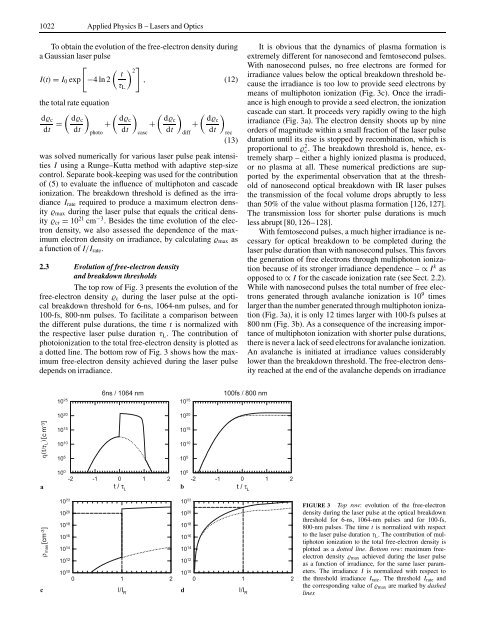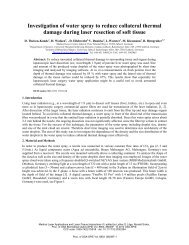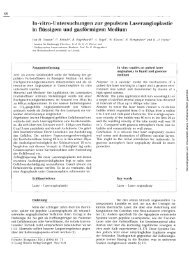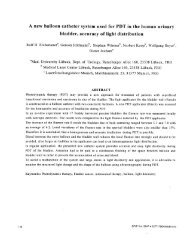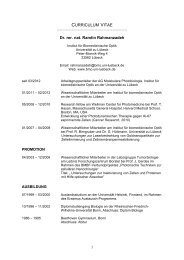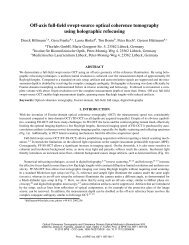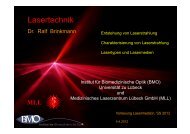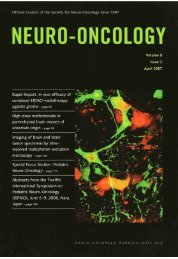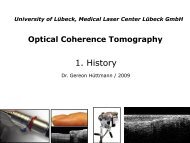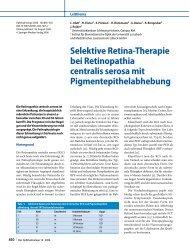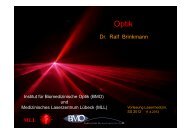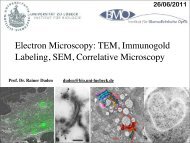1022 Applied Physics B – Lasers and OpticsTo obtain the evolution <strong>of</strong> the free-electron density duringa Gaussian <strong>laser</strong> pulse[ ( ) ]t2I(t) = I 0 exp −4ln2 , (12)τ Lthe total rate equation( )dϱ c dϱc=+dt dtphoto( ) dϱc+dt casc( ) dϱc+dt diff( ) dϱcdt rec(13)was solved numerically for various <strong>laser</strong> pulse peak intensitiesI using a Runge–Kutta method with adaptive step-sizecontrol. Separate book-keeping was used for the contribution<strong>of</strong> (5) to evaluate the influence <strong>of</strong> multiphoton and cascadeionization. The breakdown threshold is defined as the irradianceI rate required to produce a maximum electron densityϱ max during the <strong>laser</strong> pulse that equals the critical densityϱ cr = 10 21 cm −3 . Besides the time evolution <strong>of</strong> the electrondensity, we also assessed the dependence <strong>of</strong> the maximumelectron density on irradiance, by calculating ϱ max asa function <strong>of</strong> I/I rate .2.3 Evolution <strong>of</strong> free-electron densityand breakdown thresholdsThe top row <strong>of</strong> Fig. 3 presents the evolution <strong>of</strong> thefree-electron density ϱ c during the <strong>laser</strong> pulse at the opticalbreakdown threshold for 6-ns, 1064-nm pulses, and for100-fs, 800-nm pulses. To facilitate a comparison betweenthe different pulse durations, the time t is normalized withthe respective <strong>laser</strong> pulse duration τ L . The contribution <strong>of</strong>photoionization to the total free-electron density is plotted asa dotted line. The bottom row <strong>of</strong> Fig. 3 shows how the maximumfree-electron density achieved during the <strong>laser</strong> pulsedepends on irradiance.It is obvious that the dynamics <strong>of</strong> plasma formation isextremely different for nanosecond and <strong>femtosecond</strong> pulses.With nanosecond pulses, no free electrons are formed forirradiance values below the optical breakdown threshold becausethe irradiance is too low to provide seed electrons bymeans <strong>of</strong> multiphoton ionization (Fig. 3c). Once the irradianceis high enough to provide a seed electron, the ionizationcascade can start. It proceeds very rapidly owing to the highirradiance (Fig. 3a). The electron density shoots up by nineorders <strong>of</strong> magnitude within a small fraction <strong>of</strong> the <strong>laser</strong> pulseduration until its rise is stopped by recombination, which isproportional to ϱ 2 c . The breakdown threshold is, hence, extremelysharp – either a highly ionized plasma is produced,or no plasma at all. These numerical predictions are supportedby the experimental observation that at the threshold<strong>of</strong> nanosecond optical breakdown with IR <strong>laser</strong> pulsesthe transmission <strong>of</strong> the focal volume drops abruptly to lessthan 50% <strong>of</strong> the value without plasma formation [126, 127].The transmission loss for shorter pulse durations is muchless abrupt [80, 126–128].With <strong>femtosecond</strong> pulses, a much higher irradiance is necessaryfor optical breakdown to be completed during the<strong>laser</strong> pulse duration than with nanosecond pulses. This favorsthe generation <strong>of</strong> free electrons through multiphoton ionizationbecause <strong>of</strong> its stronger irradiance dependence – ∝ I k asopposed to ∝ I for the cascade ionization rate (see Sect. 2.2).While with nanosecond pulses the total number <strong>of</strong> free electronsgenerated through avalanche ionization is 10 9 timeslarger than the number generated through multiphoton ionization(Fig. 3a), it is only 12 times larger with 100-fs pulses at800 nm (Fig. 3b). As a consequence <strong>of</strong> the increasing importance<strong>of</strong> multiphoton ionization with shorter pulse durations,there is never a lack <strong>of</strong> seed electrons for avalanche ionization.An avalanche is initiated at irradiance values considerablylower than the breakdown threshold. The free-electron densityreached at the end <strong>of</strong> the avalanche depends on irradianceFIGURE 3 Top row: evolution <strong>of</strong> the free-electrondensity during the <strong>laser</strong> pulse at the optical breakdownthreshold for 6-ns, 1064-nm pulses and for 100-fs,800-nm pulses. The time t is normalized with respectto the <strong>laser</strong> pulse duration τ L . The contribution <strong>of</strong> multiphotonionization to the total free-electron density isplotted as a dotted line. Bottom row: maximum freeelectrondensity ϱ max achieved during the <strong>laser</strong> pulseas a function <strong>of</strong> irradiance, for the same <strong>laser</strong> parameters.The irradiance I is normalized with respect tothe threshold irradiance I rate . The threshold I rate andthe corresponding value <strong>of</strong> ϱ max are marked by dashedlines
VOGEL et al. <strong>Mechanisms</strong> <strong>of</strong> <strong>femtosecond</strong> <strong>laser</strong> <strong>nanosurgery</strong> <strong>of</strong> cells and tissues 1023in a much smoother way (Fig. 3d) than for ns pulses (Fig. 3c).Therefore, one can generate any desired free-electron densityby selecting an appropriate irradiance value.Figure 4 presents threshold values for irradiance, I rate ,andradiant exposure, F rate = I rate × τ L , required to reach a criticalfree-electron density <strong>of</strong> ϱ cr = 10 21 cm −3 . The thresholds werecalculated for various wavelengths and pulse durations rangingfrom 10 fs to 10 ns. Two regimes can be distinguished: forτ L < 10 ps, the threshold radiant exposure F rate exhibits onlya weak dependence on pulse duration. This reflects the factthat recombination plays only a minor role during ultra-short<strong>laser</strong> pulses. Therefore, only one set <strong>of</strong> free electrons is producedthat corresponds to an approximately constant energydensity within the focal volume. This is in accordance with theexperimental threshold criterion <strong>of</strong> bubble formation that requiresa specific energy density, which varies little with <strong>laser</strong>parameters. By contrast, for longer pulses more than one set<strong>of</strong> free electrons is produced and they recombine during the<strong>laser</strong> pulse. Here it is the threshold irradiance I rate that remainsapproximately constant, because a minimum irradiance is requiredto provide the seed electrons for the ionization cascadeby multiphoton ionization and to drive the cascade sufficientlyfast to reach the critical free-electron density within the <strong>laser</strong>pulse duration. As a consequence <strong>of</strong> the constant threshold irradiance,the radiant exposure threshold and plasma energydensity increase steeply with increasing pulse duration.The predicted form <strong>of</strong> the F rate (τ L ) dependence qualitativelymatches experimental observations <strong>of</strong> the pulsedurationdependence <strong>of</strong> single-shot damage thresholds at surfaces<strong>of</strong> transparent large-band-gap dielectrics [112, 129] andablation thresholds <strong>of</strong> corneal tissue [13, 130]. However, studiesin which single-shot thresholds at longer pulse durationsare mixed with multiple-shot thresholds at ultra-short durationsshow a steeper F rate (τ L ) dependence for τ L < 10 ps bothin corneal tissue [131, 132] and dielectrics [116, 123]. Thelower thresholds with multiple exposures are due to accumulativeeffects, the possibility <strong>of</strong> which is explained by thesmooth ϱ max (I/I rate ) dependence shown in Fig. 3d.The predicted wavelength dependence in the picosecondand nanosecond regimes (increasing threshold with decreasingwavelength) seems to be a little surprising at first sight,because multiphoton processes occur more easily at shorterwavelengths. However, one needs to keep in mind that the cascadeionization rate increases approximately proportionally tothe square <strong>of</strong> the <strong>laser</strong> wavelength, as evident from (8).2.4 Low-density plasmas in bulk mediaFIGURE 4 Calculated optical breakdown thresholds (ϱ cr = 10 21 cm −3 )asa function <strong>of</strong> <strong>laser</strong> pulse duration for various <strong>laser</strong> wavelengths. (a) Irradiancethresholds, (b) radiant exposure thesholdsOur numerical calculations for <strong>femtosecond</strong> breakdownin bulk transparent media indicate that it is possible tocreate low-density plasmas in which the energy density remainsbelow the level that leads to cavity formation in themedium. Experimental evidence for the existence <strong>of</strong> lowdensityplasmas was recently provided by Mao et al. [18]through measurements <strong>of</strong> the free-electron density in MgOand SiO 2 . Free electrons are produced in a fairly large irradiancerange below the optical breakdown threshold, witha deterministic relationship between free-electron density andirradiance. Low-density plasmas thus <strong>of</strong>fer the possibility todeliberately produce chemical changes, heating, and thermomechanicaleffects by varying the irradiance. These effects arevery well localized because <strong>of</strong> the nonlinearity <strong>of</strong> the plasmaformationprocess, which, for sufficiently small irradiances,allows us to produce a plasma in a volume that is smaller thanthe diffraction-limited focus.For larger irradiances, plasmas in bulk media grow beyondthe region <strong>of</strong> the beam waist, which is not possible forplasma formation at surfaces [116, 120, 121]. At surfaces, theenergy deposition becomes confined to a thin layer <strong>of</strong> less than100-nm thickness once the free-electron density reaches thecritical density, because the superficial plasma layer is highlyabsorbing and reflecting [116, 121, 133–135]. By contrast, inbulk media there is no restriction for the region <strong>of</strong> opticalbreakdown to spread towards the incoming <strong>laser</strong> beam withincreasing irradiance. At large irradiances, breakdown startsto occur before the <strong>femtosecond</strong> pulse reaches the beam waist,and both irradiance and beam propagation are influenced bythe plasma generation [21, 136]. These effects shield the focalregion, enlarge the size <strong>of</strong> the breakdown region, and limitthe free-electron density and energy density reached in the entirebreakdown volume [21, 80, 137–139]. Low-density plasmascan, therefore, easily be produced in bulk media whileat surfaces the self-induced confinement <strong>of</strong> plasma formationto a thin layer leads to a rapid rise <strong>of</strong> free-electron densitywith irradiance, and the irradiance range in which low-densityplasmas can be formed is very small [116, 120].The desired chemical or physical effects <strong>of</strong> low-densityplasmas can be precisely selected if the slope <strong>of</strong> theϱ max (I/I rate ) curve is small because that <strong>of</strong>fers a large


